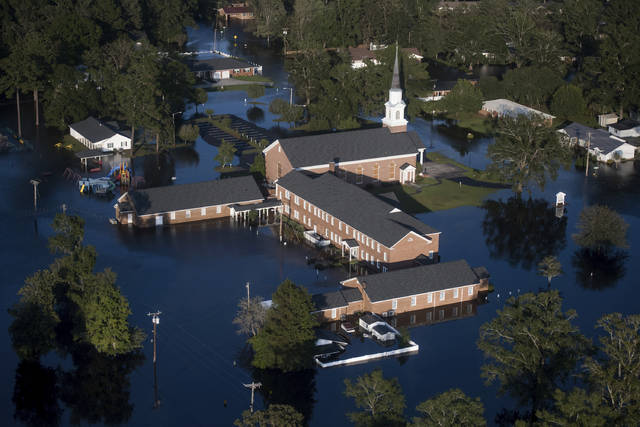CONWAY, S.C.— Two years ago, from Hurricane Matthew and in 1999, from Hurricane Floyd, floodwaters came close to entering Joe Holmes’ house in South Carolina, but he dodged those bullets. Now, with Florence , he doesn’t feel so lucky.
He worries the Waccamaw River will make its way into his Conway home because the state wants to save the main highway into Myrtle Beach, a more densely populated city and tourist destination, from going underwater.
Officials insist they must keep the road open, or hundreds of thousands of people would be isolated. So the state is building a higher wall — in the form of a second level of concrete highway barriers on top of the sides of 1.5 miles (2.5 kilometers) of bridges and causeways, sealing them with plastic sheets weighed down with sandbags and rebar — in its last stand on U.S. Highway 501.
Skeptical Conway residents fear this will push water into their neighborhoods, but officials say it won’t affect any areas that weren’t already doomed to flood — at least not in the models they’ve run.
“It’s never been done before. They can’t say for certain what it might do,” Holmes said Monday, surveying flooded areas in his golf cart. “Why is that highway so important? Why can’t they just fly food and fuel in? We’ve got a big airport.”
The Waccamaw River — which winds through Conway, population 23,000 and home to Coastal Carolina University — was already in a major flood at just over 15 feet (4.5 meters) Monday, according to the National Weather Service. The city had received 16 inches (41 centimeters) of rain from Florence’s slow march inland, and homes were already threatened. By Friday afternoon, the river should top the record of 17.9 feet (5.5 meters), set just two years ago in flooding from Hurricane Matthew, which was just inches higher than the river’s crest in Hurricane Floyd in 1999.
And it won’t stop there. By Saturday, the river should be at 18.7 feet (5.7 meters). Conway officials say they’ve been told to expect the river to rise up to an additional 2 feet (61 centimeters) after that, which would flood nearly 1,000 homes.
This weekend, the state announced its plan to save the highway from being overtopped. Given no guarantee that the temporary barrier wouldn’t cause more homes to flood, City Administrator Adam Emrick and the City Council agreed to threaten to sue to stop the project.
But on Monday, the Department of Transportation gave a presentation and convinced most Conway officials that the barrier isn’t a dam and water could continue to flow under the bridge.
“Because it is such a small distance and it isn’t a full barrier, the damming effect will be negligible,” Emrick said. “But if the river rises as forecasted, our understanding is those 944 homes will be at risk no matter what.”
Mayor Barbara Blain-Bellamy also changed her mind.
“This is the better plan for all of us,” she said. “Our ability to get goods and services depends on there being an open highway somewhere.”
Some residents and City Council members aren’t so sure.
Holmes remains worried, and he said the state bears some responsibility if his home floods.
“What they build is changing the river in some way,” Holmes said.
“There’s no doubt,” Councilman Tom Anderson agreed. “They haven’t done it before. Why do it now?”
———
This story has been corrected to show correct dates for hurricanes Matthew and Floyd in first paragraph. Matthew was in 2016, Floyd in 1999.
———
Follow Jeffrey Collins on Twitter at https://twitter.com/JSCollinsAP .
Read his work at https://apnews.com/search/jeffrey%20collins .
———
For the latest on Hurricane Florence, visit https://www.apnews.com/tag/Hurricanes .


